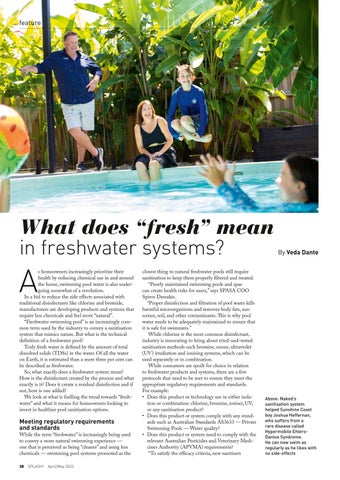feature
What does “fresh” mean in freshwater systems?
A
s homeowners increasingly prioritise their health by reducing chemical use in and around the home, swimming pool water is also undergoing somewhat of a revolution. In a bid to reduce the side effects associated with traditional disinfectants like chlorine and bromide, manufacturers are developing products and systems that require less chemicals and feel more “natural”. “Freshwater swimming pool” is an increasingly common term used by the industry to convey a sanitisation system that mimics nature. But what is the technical definition of a freshwater pool? Truly fresh water is defined by the amount of total dissolved solids (TDSs) in the water. Of all the water on Earth, it is estimated than a mere three per cent can be described as freshwater. So, what exactly does a freshwater system mean? How is the disinfectant created by the process and what exactly is it? Does it create a residual disinfection and if not, how is one added? We look at what is fuelling the trend towards “freshwater” and what it means for homeowners looking to invest in healthier pool sanitisation options.
Meeting regulatory requirements and standards
While the term “freshwater” is increasingly being used to convey a more natural swimming experience — one that is perceived as being “cleaner” and using less chemicals — swimming pool systems promoted as the 38
SPLASH!
April/May 2022
closest thing to natural freshwater pools still require sanitisation to keep them properly filtered and treated. “Poorly maintained swimming pools and spas can create health risks for users,” says SPASA COO Spiros Dassakis. “Proper disinfection and filtration of pool water kills harmful microorganisms and removes body fats, sunscreen, soil, and other contaminants. This is why pool water needs to be adequately maintained to ensure that it is safe for swimmers.” While chlorine is the most common disinfectant, industry is innovating to bring about tried-and-tested sanitisation methods such bromine, ozone, ultraviolet (UV) irradiation and ionising systems, which can be used separately or in combination. While consumers are spoilt for choice in relation to freshwater products and systems, there are a few protocols that need to be met to ensure they meet the appropriate regulatory requirements and standards. For example: • Does this product or technology use in either isolation or combination: chlorine, bromine, ioniser, UV, or any sanitisation product? • Does this product or system comply with any standards such as Australian Standards AS3633 — Private Swimming Pools — Water quality? • Does this product or system need to comply with the relevant Australian Pesticides and Veterinary Medicines Authority (APVMA) requirements? “To satisfy the efficacy criteria, new sanitisers
By Veda Dante
Above: Naked’s sanitisation system helped Sunshine Coast boy Joshua Heffernan, who suffers from a rare disease called Hypermobile EhlersDanlos Syndrome. He can now swim as regularly as he likes with no side-effects
